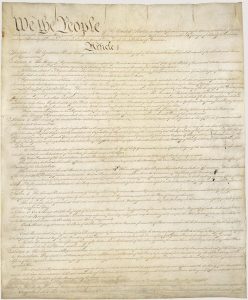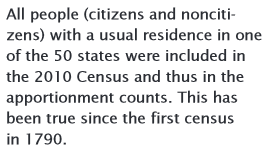CENSUS, REDISTRICTING BASED ON NUMBER OF “RESIDENTS,” NOT “CITIZENS”
by Sharon Rondeau

(Oct. 18, 2015) — A report prepared by the U.S. Census Bureau explains that the apportionment of congressmen in the U.S. House of Representatives, the number of which is set at 435, occurs following each census by the provision found in Article 1, Section 2 of the U.S. Constitution.
The most recent census was conducted in 2010 and determined that there was a 308,745,538 “resident population” in the United States at that time. Based on population shifts away from the Midwest and Northeast, the states of Texas, Florida and several others were allotted a greater number of respective representatives in the House, while states with diminishing populations experienced a net loss of seats.
It is now reported as more than 321 million.
A U.S. House of Representatives explanation of “proportional representation” as established by the Framers refers to both the applicable section of Article 1 and to the 14th Amendment, which states that reapportionment would be carried out by “counting the whole number of persons in each State.”
Along with reapportionment, redistricting also occurs following the census. According to Census.gov, “Redistricting Data Program (RDP)” plans showing redrawn congressional districts were “submitted to the Census Bureau by non-partisan state liaisons, identified by the governor and legislative leadership of each state during Phase 1 of the RDP.”
However, redistricting in Florida, Texas, Maryland and other states has been challenged in the courts. Three cases from as many states will be heard by the U.S. Supreme Court during its new term, which runs through June of next year.
 In the 1960s, the Supreme Court interpreted the Constitution’s provision for reapportionment and redistricting to require that every legislative district within a state contain as close to the same number of people as every other so that votes would not be diluted by under-representation as compared to other districts.
In the 1960s, the Supreme Court interpreted the Constitution’s provision for reapportionment and redistricting to require that every legislative district within a state contain as close to the same number of people as every other so that votes would not be diluted by under-representation as compared to other districts.
According to a collaborative which seeks more transparency in redrawing districts following the census, “Much of the work of redistricting takes place behind closed doors. Legislators and political consultants decide which streets or neighborhoods are in or out, specialists make the maps, and the public has little opportunity to weigh in. Districts are often crafted for political gain – a practice known as gerrymandering.“
During the Constitutional Convention of 1787, the Framers adopted “The Great Compromise,” also known as the “Connecticut Compromise,” which allowed for popularly-elected members of the House of Representatives and U.S. Senators chosen by the respective state legislatures to represent the best interests of each state. The 17th Amendment changed the election of senators to the same as for members of the House.
A congressional act passed in 1929 maximized the number of representatives at 435 and ensured that reapportionment in the House would take place following each census-taking. At the time, a prominent Democrat member of the House opposed the law, contending that it was unconstitutional, while the Republican Majority Leader lauded it.
Based on the results of the 2010 census, Census.gov reported:
The average size of a congressional district based on the 2010 Census apportionment population will be 710,767, more than triple the average district size of 210,328 based on the 1910 Census apportionment, and 63,815 more than the average size based on Census 2000 (646,952). Based on the 2010 Census apportionment, the state with the largest average district size will be Montana (994,416), and the state with the smallest average district size will be Rhode Island (527,624).
On page 7 of the 2010 census report, the question “Were undocumented residents in the 50 states included in the 2010 Census apportionment population counts?” was answered with:
Various sources have estimated the illegal-alien population in the U.S. to be between 11 and 12 million people. Some reports suggest that illegals may not be willing to answer census questions and therefore do not add to the final population count.
According to History.com, the passage in 1965 of the Immigration and Nationality Act was effected out of a sense that the “quota system” should be changed to include more individuals from outside of northern Europe. At the time, President Lyndon B. Johnson predicted that the bill’s enactment would “not affect the lives of millions….It will not reshape the structure of our daily lives or add importantly to either our wealth or our power.”
The 1990 Immigration Act “increased the limits on legal immigration to the United States, revised all grounds for exclusion and deportation, authorized temporary protected status to aliens of designated countries, revised and established new nonimmigrant admission categories, revised and extended the Visa Waiver Pilot Program, and revised naturalization authority and requirements.”
 In 2006, the Christian Science Monitor, quoting Tucson, AZ U.S. Border Patrol Local 2544, reported that there were between 12 and 15 million illegals in the country. In 2008, the Federation for American Immigration Reform (FAIR) reported that there were 13 million illegals in the country.
In 2006, the Christian Science Monitor, quoting Tucson, AZ U.S. Border Patrol Local 2544, reported that there were between 12 and 15 million illegals in the country. In 2008, the Federation for American Immigration Reform (FAIR) reported that there were 13 million illegals in the country.
In 2013, The New York Times reported that in 1990, there were 3.5 illegals in the U.S. Citing a report published by the Pew Research Center stating the then-current illegal-alien population as 11.7 million, The Times stated that “the population of immigrants here illegally did not decline significantly from 2009 to 2012.”
During the summer of 2014, approximately 60,000 people characterized as mostly “unaccompanied migrant children” were allowed in to the U.S. through its southern border, nearly all of whom were provided with emergency housing, food, medical care, and eventual settlement with relatives or in foster homes.
Although the federal government made preparations for the arrival of “UACs” in January of last year, the influx over the summer was described as a “humanitarian crisis.”
Illegal aliens are often educated, housed, fed, clothed, provided medical care and imprisoned, if necessary, at the expense of U.S.-citizen taxpayers. In 2011, the General Accounting Office (GAO) reported that “As of fiscal year 2009, DHS estimated that the total alien population in the United States was about 25.3 million. Some of the alien population have been arrested and incarcerated in federal and state prisons and local jails, adding to already overcrowded prisons and jails. The federal government bears the total cost of incarcerating all criminal aliens in federal prisons and reimburses state and local governments for portions of their incarceration costs for certain criminal alien populations through SCAAP. Any costs related to incarcerating criminal aliens not reimbursed by the federal government are borne by state and local governments.”
Illegals have not sworn an oath of allegiance to the United States.
According to FAIR, citing studies from the Center for Immigration Studies (CIS), in regard to employment statistics, “all net new jobs went to immigrants from November 2007 to November 2015.”
Some cities and towns have approved voting rights for illegal aliens in School Board elections and matters having to do with their children’s taxpayer-funded education.
In an article dated December 30, 2012 at The American Thinker, author Michael Bargo Jr. referred to an article at The Heritage Foundation which reported that in 1982, the U.S. Attorney for Chicago “estimated that at least 100,000 fraudulent votes (10 percent of all votes in the city) had been cast.[2].” In the Heritage article, dated April 16, 2008, writer Hans A. von Spakovsky posited that, “This case of voter fraud is worth studying today because it illustrates the techniques that political machines and organized political groups use to steal elections. Even in the present day, this threat is not hypothetical: Tactics similar to those documented in the Chicago case have come to light in recent elections in Philadelphia and in the states of Wisconsin and Tennessee. The Daley machine may be legendary in modern times for its election fraud prowess, but these recent cases show that the incentives and opportunities for fraud have not lessened. Guarding against these tactics can make the difference between a fair election and a stolen election, particularly where the margins of victory are narrow and just a few fraudulent votes can change the outcome.”
Bargo additionally reported, “Since 1985 Chicago has pioneered new ways to promote illegal immigration. After 1990 the illegal immigrant population in Chicago and the nation skyrocketed. As illegal immigrants flocked to Chicago, a method was needed to get them on the registered voter list. Although 80,000 illegal aliens voted in 1982, the old-fashioned way, through vote fraud; by 2005 both Cook County and the state of Illinois had moved to allow photo I.D. to be given to illegal immigrants by passing matricula consular laws.”
In his piece at Heritage, van Spakovsky detailed how the significant voter fraud was determined to have occurred in Chicago in 1982:
On the day of the general election, dishonest precinct captains kept careful track of who came to the polls to vote. Runners working for the precinct captains not only supplied rides for voters, but also noted “who would not be coming to the polls because they were too sick, were too drunk, had recently moved away, or had died.”
Precinct captains supplied the names of those absent voters to other participants in the fraud, and “ballots either were punched on the voting machines by people posing as the voter, or were punched with ball point pens or other similar objects in a private place outside the polling areas by the precinct captain or his workers.”[32] Some of the defendants even “went into washrooms, where they practiced forging the signatures” of those whom they believed would not vote.[33]
Registering Aliens. Aliens who were illegally registered were another source of potential votes “for the unscrupulous precinct captain.” The grand jury found that many aliens “register to vote so that they can obtain documents identifying them as U.S. citizens” and had “used their voters’ cards to obtain a myriad of benefits, from social security to jobs with the Defense Department.”[34] In fact, three aliens were charged “with attempting to get U.S. passports by using their voter registration cards.”[35]
U.S. Attorney Dan Webb estimated that 80,000 illegal aliens were registered to vote in Chicago.[36] Dozens of aliens were indicted and convicted for registering and voting,[37] and one individual was indicted for recruiting an illegal alien to register to vote.[38]
 In 1985, a man known as “Barack Hussein Obama” reportedly went to Chicago to work as a community organizer after graduating from Columbia College and working for two years in New York City. His life narrative states that he attended Harvard Law School from 1988 to 1991 and then returned to Chicago, where he met his wife, then-Michelle Robinson. In 1995, Obama decided to seek the Illinois state senate seat for which Alice Palmer temporarily chose not to run, having decided to seek election to the U.S. House instead.
In 1985, a man known as “Barack Hussein Obama” reportedly went to Chicago to work as a community organizer after graduating from Columbia College and working for two years in New York City. His life narrative states that he attended Harvard Law School from 1988 to 1991 and then returned to Chicago, where he met his wife, then-Michelle Robinson. In 1995, Obama decided to seek the Illinois state senate seat for which Alice Palmer temporarily chose not to run, having decided to seek election to the U.S. House instead.
The Obama campaign challenged the signatures collected by many of his primary opponents, all of whom were ultimately disqualified, and Obama ran for the seat, which represented Cook County, unopposed. On his campaign website, 2010 Chicago mayoral candidate Jay Stone contended that “During Obama’s 1996 state senate primary race, it was Obama campaign worker Ron Davis who acted as Obama’s surrogate. The fact that Harvard law school graduate Barack Obama chose Ron Davis instead of himself to knock his four opponents off the ballot shows that Barack Obama was steeped in dirty Chicago politics from the inception of his political career.”
The Obama state senate campaign challenged the authenticity of his opponents’ signatures, with the Chicago Board of Elections declaring 62% of them invalid. “The CBOE’s Questionable Decisions Made Barack Obama the Chosen One,” Stone claimed.
As White House occupant, Obama’s long-form birth certificate and Selective Service registration form have been declared by a law enforcement investigation to be “computer-generated forgeries.”
Of the 2008 presidential election, History.com wrote that “There could be perhaps no greater reflection of the impact of immigration than the 2008 election of Barack Obama, the son of a Kenyan father and an American mother (from Kansas), as the nation’s first African-American president.” However, Obama’s claimed father was not an immigrant, but rather, admitted to the U.S. on a student visa before its renewal was denied based on his reported inappropriate conduct while attending Harvard.
In 1993, President Bill Clinton signed the National Voter Registration Act (NVRA), which mandates that state motor vehicle departments provide voter registration opportunity to individuals renewing their drivers’ licenses and that state social service departments do the same for benefit applicants.
Although rejected nationally after the attacks of 9/11, in 2002, Cook County, IL voted to accept a “matricula consular,” purportedly issued by the Mexican government, as a valid form of identification. Some banks also began accepting the card “as a valid form of ID.”
Of the 2000 census and its accompanying congressional reapportionment, CIS wrote that “Immigrant-induced reapportionment is different from reapportionment caused when natives relocate to other states. Immigration takes away representation from states composed almost entirely of U.S. citizens and results in the creation of new districts in states with large numbers of non-citizens.”
In January 2003, the CIS reported that the matricula consular was reported by Mexico to have been accepted in 13 states. Further, the CIS wrote:
Matricula Leads to a Drivers License
As we saw with the hijackers, illegal aliens of all nationalities prize a state-issued driver’s license above all other identity documents because it serves as a domestic passport. It is the most widely accepted identity document in America and gains you access to places, services, and transportation. Once a Mexican has a driver’s license, he or she could throw away their matricula. It would no longer be needed…Consulate officials are actively lobbying other states to either alter motor vehicle department regulations regarding acceptable identity documents for undocumented aliens or pass legislation that would explicitly permit acceptance of the matricula.
The new, improved matricula became available to residents of New York, New Jersey, and Connecticut in March 2002. The news was announced by the regional Mexican consul who said “The ideal would be if the matriculation card could gain points to obtain a driver’s license in the tri-state area. . . . We are holding talks now with representatives from the departments of transportation of the three states.”22
In an October 2003 article titled, “Remaking the Political Landscape: The Impact of Illegal and Legal Immigration on Congressional Apportionment,” CIS reported that “The United States is currently experiencing the largest wave of immigration in its history. By the end of the 1990s, at least 1.5 million legal and illegal immigrants were arriving each year, leading to a total foreign-born population of over 31 million by 2000. A little noticed effect is the way in which immigration impacts the distribution of seats in the U.S. House of Representatives. Apportionment is based on each state’s total population — including illegal aliens and other non-citizens — relative to the rest of the country.”
In June 2007, Judicial Watch reported that “The integrity of the U.S. voting system has been compromised many times in the past with documented incidents of illegal immigrants and non citizens casting ballots. The Federation for American Immigration Reform has tracked numerous instances when non citizens voted in major elections in various states, including California and Florida.”
In September 2008, an editorial published at CBS News contended:
Aside from the burdens posed by illegal immigrants on crime, detention facilities, job security, taxes, wages, social security, medicare, Medicaid, violence, terrorism and drug and human trafficking, illegal aliens are slowly eroding the power of American voters.
Though illegal immigrants dont have an effect on the popular vote, they are changing the electoral vote, and this change benefits Obama.
Hispanic voters historically vote Democratic, and as reported by USA Today in July, Hispanics will become decisive swing votes in future elections.
With the Hispanic population set to double to 30 percent by 2042 because of relatively higher birth rates and immigration and with leaders like Obama and McCain who support amnesty for illegal aliens this traditionally Democratic-leaning population will likely tip future elections in favor of Democrats.
In 2013, plaintiffs in a Texas lawsuit challenged the counting of all members of the “total population” as opposed to “eligible voters” in redrawing the state senate district. An informational website reported that “In Texas, the major driver of disparities in the number of eligible voters is the high number of non-citizens in parts of the state – mainly its urban and suburban cores. For example, in places like Dallas and Houston, commonly accepted estimates are that around half of adult Hispanics are non-citizens.”
Beginning on January 1 of this year, illegal aliens were allowed to obtain driver’s licenses in Connecticut under certain conditions under the contention that “highway safety” would be improved. Prior to 2015, 11 other states and the District of Columbia had adopted the practice.
California, which is thought to have the largest number of illegals, began issuing driver’s licenses to that population in 2013.
In 2012, by executive action on the part of Chicago Mayor Rahm Emanuel, Chicago became a “sanctuary city.” According to a Newsmax article published on October 5, 2012, “The current code word for Chicago’s daily shootings and killings is not ‘murder’ but ‘violence.’ No mention is made by the mayor that the gangs committing the ‘violence’ are Hispanic and include large numbers of illegal aliens. Chicago now ranks above Montgomery County, Md., and Los Angeles both with sanctuary designations, as home to the nation’s most vicious illegal alien criminal gangs.”
 Chicago has become one of America’s deadliest cities, with 60 deaths occurring in September 2015.
Chicago has become one of America’s deadliest cities, with 60 deaths occurring in September 2015.
CIS reports that the number of “sanctuary jurisdictions” is 340. On Tuesday, the U.S. Senate will vote on a bill which, if passed, would deny some federal funding to sanctuary cities, of which there are now scores, if not hundreds.
Some state legislatures are considering bills which would prohibit the establishment of sanctuary cities within their boundaries.
In June 2012, Obama announced by executive memorandum that young illegal aliens would not face deportation if they applied and qualified for the “DACA” program, which was not approved by Congress. Several DACA participants have since been arrested for crimes, including murder.
In contrast to the George W. Bush administration’s policy toward seeking out illegal aliens for deportation, the Obama regime has changed policy such that only the most hardened criminals be deported, particularly since November 20, 2014, when Obama announced that he would implement “executive actions” to allow millions of illegals to remain in the country if they met certain conditions.
An executive memorandum ordered the creation of “Welcoming Communities” and a program to facilitate “the civic, economic, and linguistic integration of new Americans,” who are identified as “immigrants” and “refugees.”
The DAPA executive actions have been successfully challenged in federal court and remain on hold, although the regime has admitted that some of the elements of the proposed “DAPA” program have already been implemented, raising the ire of a federal judge.
In regard to federal representation, several sources have reported that illegal alien voters could have significantly affected the outcome of the 2008 presidential election.
Of their effect on national elections, American Thinker’s Bargo reported:
Enabling foreign nationals to vote in Illinois allowed the Democrats to manipulate not just local and state elections, but the presidential election as well. This is because the electoral college is not based on votes counted, but on population. The 2000 Census found that in 19 of the 100 largest U.S. cities the only part of the population that is growing is the Hispanic segment. Mexican families have twice as many children as white families. And children are also counted by the Census Bureau to determine the number of Congressional Representatives. The larger the population a state has, the more electoral college members it has. States that are solidly Democratic can continue to extend their influence on the Presidential elections by extending their Hispanic populations. Today, one in four children born in the U.S. is Hispanic.
Last month, in describing the U.S. as a “beacon of hope,” Secretary of State John Kerry pledged to admit 100,000 “worldwide refugees” each year by 2017 in response to the “migrant crisis” presently causing chaos in many European countries resulting from Middle Eastern “refugees,” many of whom appear to be young men without wives and children.
In 2009, then-White House chief of staff Rahm Emanuel said publicly, “You never want to let a serious crisis go to waste.”


